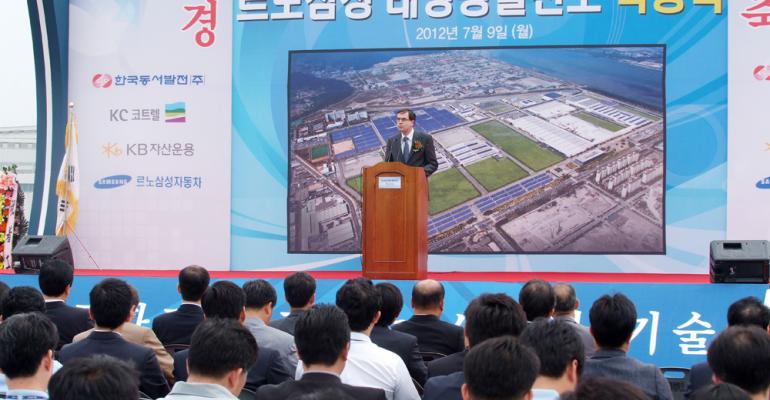Renault Samsung is Korea’s least-productive auto maker, with global and domestic sales tumbling month after month. But it soon will become the country’s – and the world’s – leading user of solar panels to power manufacturing operations.
Renault Samsung President Francois Provost conducts a press conference and walk-through of the auto maker’s planned 20-Mw solar-generating system that will power its Busan plant and provide nearly 11% of its electric output to 7,500 homes near the facility.
The project will cost 56 billion won ($50 million) and will be completed by December, he says, adding it is the largest industrial manufacturing solar power system in the world and the first of its kind in Korea.
“Renault Samsung Motors continues to lead the environmental vehicle industry,” says Provost, adding the plant is part of the auto maker’s plans to begin commercial production of electric vehicles in 2014. “We will continue to carry out more eco-friendly alternative-energy projects and be a role model for local and overseas companies.”
The system consists of photovoltaic solar panels installed in all of the plant’s expansive parking lots, on the roofs of all buildings and in an additional 3.23 million sq.-ft. (300,000 sq.-m) of unusable land located within the 5.38-million sq.-ft. (500,000-sq.-m) site owned by Renault Samsung.
Roughly two-thirds of the reclaimed swampland on which the factory was built has no commercial or industrial value. Formerly a property of Samsung Motors, which was a subsidiary of Samsung Corp., the plant and other buildings required the sinking of numerous concrete caissons and was an engineering feat said to have driven the cost of the plant’s development to nearly $2 billion.
Provost says that by providing houses in the area with surplus solar power, carbon-dioxide emissions generated by residential sources will be reduced by 13,000 tons (11,800 t) annually.
He notes Renault Samsung since January has operated a 1-megawatt solar-panel system at its parts-supply center in Haman, in South Gyeongsang province.
The auto maker has established a separate joint venture, Busan Shinho Solar Plant, to own and operate the system. Its partners are the Korea East-West Power subsidiary of state-owned Korea Electric Power, and solar-panel manufacturer KC Cottrell, which is based in Korea with subsidiary operations in the U.S., China and Vietnam.





